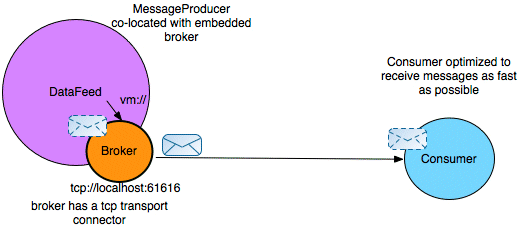An obvious way to improve network performance is to eliminate one of the hops in the messaging application. With a standalone broker, at least two hops are required to route a message from producer to consumer: the producer-to-broker hop and the broker-to-consumer hop. On the other hand, by embedding the broker (either in the producer or in the consumer), it is possible to eliminate one of the hops, thereby halving the load on the network.
Figure 1.1 shows an example of a data feed that
acts as a message producer, sending a high volume of messages through the broker. In
this case, it makes perfect sense for the broker to be co-located with the data
feed, so that messages can be sent directly to the consumers, without the need for
an intermediate hop. The simplest way to create an embedded broker is to exploit
Fuse Message Broker's vm:// transport.
You can connect to a vm:// endpoint from a producer or a consumer in
just the same way as you connect to a tcp:// endpoint (or any other
protocol supported by Fuse Message Broker). But the effect of connecting to a
vm:// endpoint is quite different from conecting to a
tcp:// endpoint: whereas a tcp:// endpoint initiates a
connection to a remote broker instance, the vm:// endpoint actually
creates a local, embedded broker instance. The embedded broker
runs inside the same JVM as the client and messages are sent to the broker through
an internal channel, bypassing the network.
For example, a Apache Camel client can create a simple, embedded broker instance by connecting to a URL of the following form:
vm://brokerNameWhere brokerName uniquely identifies the embedded
broker instance. This URL creates a simple broker instance with a default
configuration. If you want to define the broker configuration precisely, however,
the most convenient approach is to specify a broker configuration file, by setting
the brokerConfig option. For example, to create a myBroker
instance that takes its configuration from the activemq.xml
configuration file, define the following VM endpoint:
vm://myBroker?brokerConfig=xbean:activemq.xml
For more details, see ????.
By default, the embedded broker operates in asynchronous mode, so that calls to a send method return immediately (in other words, messages are dispatched to consumers in a separate thread). If you turn off asynchronous mode, however, you can reduce the amount of context switching. For example, you can disable asynchronous mode on a VM endpoint as follows:
vm://brokerName?async=false![[Note]](imagesdb/note.gif) | Note |
|---|---|
If both the broker option, |









